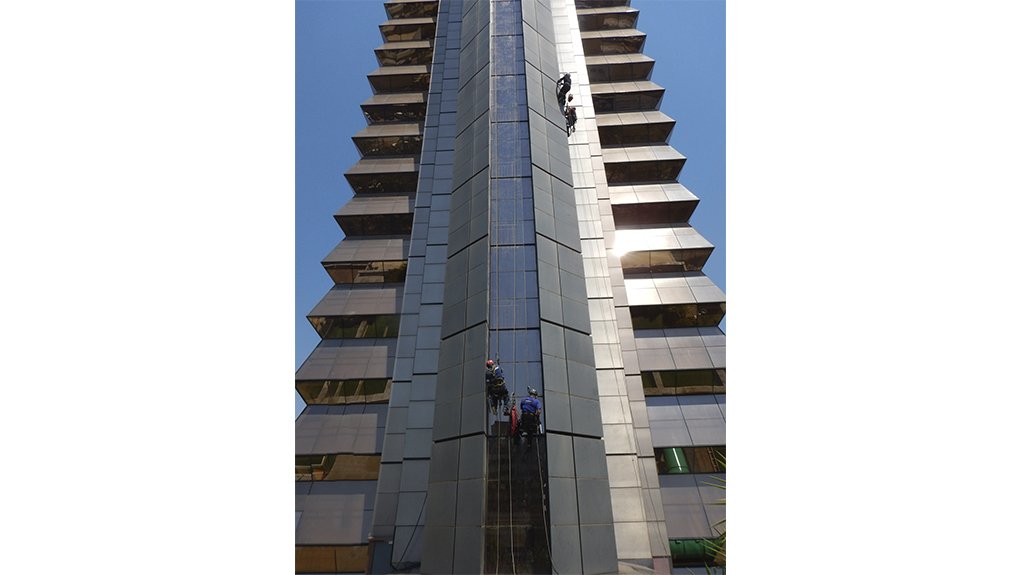Rope access specialist Skyriders’ working-at-height training includes rope access, fall arrest or fall prevention and the fall protection plan.
The company specialises in rope access & RPAS (drones) – a system used to position a person on a structure.
“Although we are an industrial rope access company, our teams might need to use basic fall-arrest techniques to get to the edge of a high building for example, after which they use a rope access system and techniques to physically climb over the edge and descend to the work position to perform inspection, maintenance, painting, welding and bolting,” says Skyriders marketing manager Mike Zinn.
He explains that an alternative would have been to build an access structure, such as scaffolding, or use a cherry picker big and high enough to be able to reach that position.
Rope Access Qualifications
Zinn explains that there are three levels of rope access qualifications.
Level 1 comprises the basic manoeuvres to perform rope access work safely, which takes six days to complete.
To progress from Level 1 to Level 2, a student must have a logbook containing
1 000 certified hours of experience, signed off by a supervisor.
Level 2 training course takes eight days to complete – two days are used to focus on theory and six days to focus on the practical experience, which involves more manoeuvres and more complicated and advanced rescue procedures.
Once a student has completed another 1 000 hours after completing level two, the student will then move to level three.
Level 3 involves even more advanced rigging, as well as performing difficult rescues and procedures at height. It is the most senior rope access level, enabling students to become rope access supervisors. The course spans eight days, he notes.
Fall Arrest Courses
All fall-arrest courses involve standing, or moving, on temporary structures.
The Basic Fall course requires that a student wears a basic fall arrest harness while 2 m above ground. This enables a student to become familiar with the basics of keeping safe while performing work at height, Zinn explains.
The course is accredited and registered with industry body, The Institute for Work at Height (IWH), and takes about a day-and-a-half to complete.
Further, Basic Fall Arrest & Rescue as the next level of course now includes a rescue module, which teaches students how to rescue an individual who has had a fall arrested by his equipment or personal protective equipment but now needs to be rescued. The course takes about two-and-a-half days to complete.
The last course is for fall arrest rescue technicians. Students need to have completed the previous two levels to qualify for this course. The course takes six days to complete, he states.
It is recommended that companies involved in working at height have teams that can execute the correct work at height practices and it is required for companies to have all employees properly trained by an IWH-accredited training provider fall-arrest rescue technician on site, Zinn points out.
Fall Prevention
There is a hierarchy of preferred options when considering work at height and the potential of a fall. The first is avoiding work at height by carrying out the work from the ground.
However, if there is no alternative but to work at height, then the necessary equipment and training has to be used to prevent a fall from occurring or in the worst case limit the distance of the fall and the consequences thereof, he notes.
Fall-prevention or arrest equipment can be grouped into two main categories.
In the collective, or passive, category, no action is required by the user to achieve protection, for example, a handrail. The personal or active category requires an action by the user to achieve protection, for example, a safety line that the user must clip on for protection.
Fall Protection Plan
Many companies are not aware that having a fall protection plan is a legislative requirement that is dictated by construction regulations, says Zinn.
The regulations state that a company is required to have a fall protection plan in place when any work where there is the risk of a fall from height is undertaken.
“The plan has to be drafted and put together by a competent person.”
“Further, employees can obtain this qualification through any accredited IWH training provider offering the Fall Protection Planners course (Unit Standard 229994)
Zinn concludes that where detailed fall protection planning is in place, and all the relevant aspects are in good order, such as competencies, planning, medicals, equipment et cetera, there are fewer possibilities of experiencing safety incidents.
Edited by: Zandile Mavuso
Creamer Media Senior Deputy Editor: Features
EMAIL THIS ARTICLE SAVE THIS ARTICLE
ARTICLE ENQUIRY
To subscribe email subscriptions@creamermedia.co.za or click here
To advertise email advertising@creamermedia.co.za or click here













